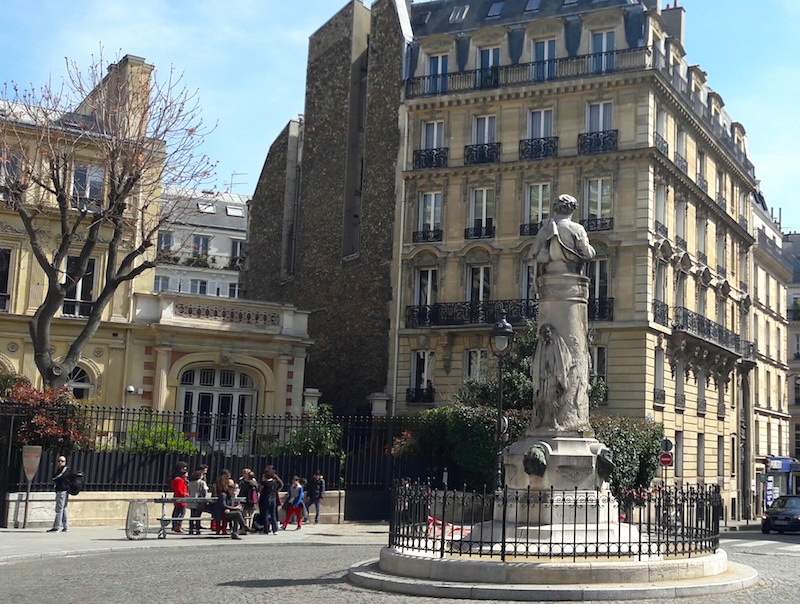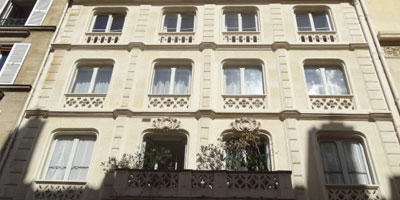THE WALK
During this 1 hour walk, discover the ” Nouvelle-Athènes”, name given to the part of the 9th district that grew up during the 19th century when the intellectual and artistic elite (writers, painters, musicians, politicians, …) settled in there and had wonderful town houses built. It is besides in the course of this century that appeared the romantic movement, represented nowadays by the Museum of Romantic life.
Formerly called “quartier des Porcherons” – area full of café with live music and cabarets in the middle of orchards – the Nouvelle-Athènes takes its name from the ancient-Greece taste of the architects that have built the town houses and buildings of the district.
THE ITINERARY
- The walk begins at Notre Dame de Lorette metro station (L 12). This parish, built by the architect Hippolyte Lebas, is a neo-classic masterpiece of the 18th century. Visit the church and go to rue Saint-Georges, on the left side of the church.
- Take next rue Saint-Lazare on your left, and turn right onto rue Taitbout. At the number 80 is a private residence, registered historical site since 1977. Here have lived, amongst other artists, Georges Sand and Frédéric Chopin.
- Go ahead rue Taitbout as far as rue d’Aumale. This very quiet street offers a typical architecture of Nouvelle-Athènes buildings. Note first and foremost the homogeneity of the buildings, all dressed-stone made. Turn right and go as far as rue Saint-Georges. Then go to Place Saint-Georges on your left.
- At the numbers 26 and 28 of Place Saint-Georges are two wonderful private mansions. The sumptuous hôtel de la Marquise de Païva (n° 28) is one of the most beautiful town house of the district. On the middle of the Place is a statue of Paul Gavarni, famouse illustrator and cartoonist of the 19th century. Go straight on and take rue Notre-Dame de Lorette (going up). You are in the heart of the Nouvelle-Athènes…
- Turn right rue Henry Monnier, then turn right again onto rue Clauzel. You will find at the number 14 of this street the former shop of the “Père Tanguy”, colour merchant of impressionist artists as Pissaro, Monet, Renoir, Van Gogh… Paid with paintings in exchange for goods, Père Tanguy became one of the first impressionist dealer of Paris. At the other side of the street (n° 7 ter) is another beautiful town house of the 19th century.
- At the end of rue Clauzel, you are rue des Martyrs, the main shopping street of the district. You will feel there the atmosphere of Paris village prevailing in the Nouvelle-Athènes. Climb the street and turn left onto rue de Navarin. Go to the number 9. This amazing building was a brothel…
- Go back rue des Martyrs and continue straight ahead. Turn left onto rue Victor Massé.
- You are in the district of Paris dedicated to music (and particularly guitar). Go straight ahead for about 1 kilometer from rue Victor Massé until rue de Douai. Enjoy your walk in this street to the rhythm of the sound of the instruments (take notice that all shops are closed on monday…).
- Continue rue de Douai as far as Place de Clichy, one of the most important crossroads of Paris astride 4 arrondissements (8e, 9e, 17e and 18e)! Turn right and go ahead onto boulevard de Clichy.
End of the walk
|
– Eugène Delacroix lived, from 1844 to 1857, at n°58 rue Notre-Dame-de-Lorette. Paul Gauguin was born n°56 – Jean-Baptiste Pigalle, sculptor (1714-1785), lived from 1756 to 1782 at n°17 of rue Jean-Baptiste Pigalle – Théodore Géricault (painter and sculptor) lived 21 rue des Martyrs – Adolphe Thiers, 1st Président of the third French Republic lived 27, place Saint-Georges |


